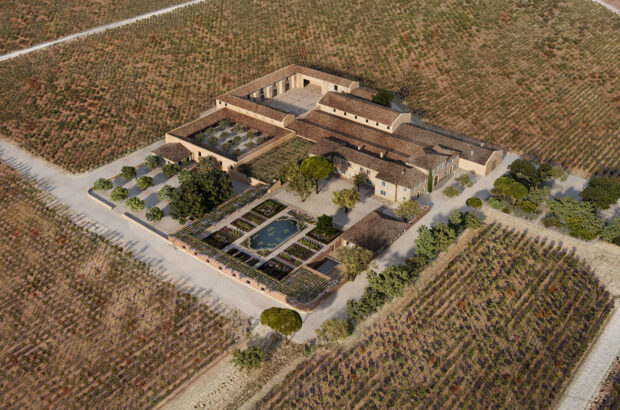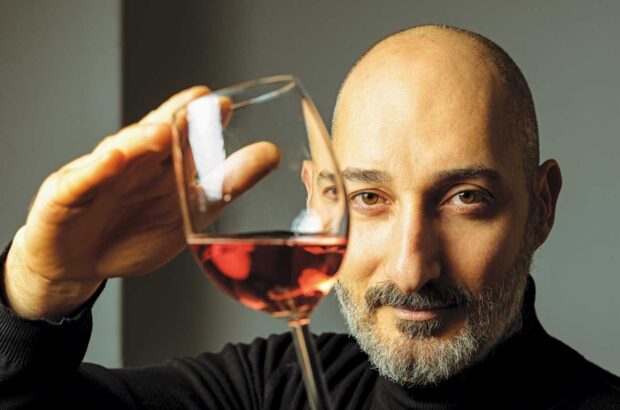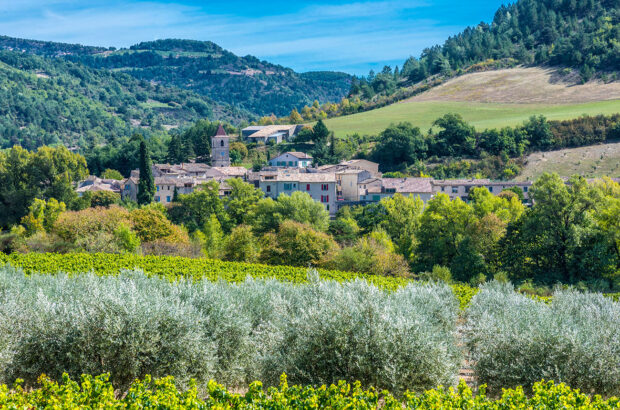The confusing myriad of wines in the Coteaux du Languedoc is slowly being organised into a new hierarchy. JAMES LAWTHER MW tastes through the different terroirs and recommends their top wines.
The Languedoc-Roussillon is still in a state of flux and nowhere more so than the Coteaux du Languedoc. One of France’s most exciting appellations, a source of bold new wines with marked identity, it is also a huge, unwieldy state with 14,970ha (hectares) under production.
Fortunately, a system of hierarchy is slowly being established to help make sense of the region. At base level is ‘generic’ Coteaux du Languedoc, with existing rules for production such as yield and grape variety. Thereafter seven climatic zones (see following page) have been defined as sub-regions, with more detailed controls on production. So far Pic St-Loup and La Clape have been given an official decree and the right to display their names on the label. Grès de Montpellier will follow in 2003, with Terrasses de Larzac possibly the next in line.
Next step up the pyramid is communal level where both soil and climate are taken into account, the rules again refined and full appellation status received. Faugères is a clear example of this with Pic St-Loup presently under consideration.
To demonstrate the different Coteaux du Languedoc styles, the Syndicat des Coteaux du Languedoc organised a blind tasting of 150 wines (mostly red) for Decanter at its Mas de Saporta headquarters near Montpellier. On the whole the argument was convincing providing the wine had at least a year in bottle, though grape variety (particularly Syrah) and winemaking (carbonic maceration) occasionally overshadowed the notion of a regional style.
The overall quality of the Coteaux du Languedoc wines – mainly the 2000 vintage with some samples of the powerful 2001 – was very good. Faugères and Pic St-Loup stood out as the most affirmed styles, while Terrasses de Larzac had some of the most exciting, original wines. Outlined below is a guide to the regional styles and the pick of the wines in terms of quality and typicity.
https://www.decanter.com/wine-news/chateau-faugeres-sold-97777/
ON THE COAST (EAST TO WEST)
GRES DE MONTPELLIER
This zone will officially become a sub-region in 2003 with the designation appearing on labels from the 2002 vintage. Running northeast and southwest of Montpellier, the temperatures are warm, rainfall low (500mm) and there is a Mediterranean maritime influence. Soils include a large expanse of stony galets roulés, similar to those in Châteauneuf-du-Pape. The wines are big, warm and full with deep colours and ripe notes of fig and jammy fruit.
CHATEAU ST MARTIN DE LA GARRIGUE 2000 Dark hue. Ripe, cassis nose. Rich, round concentration. Plenty of dark fruits and spice. Firm finish. 3–7 years. £5.92 (wholesale); QtA
CHATEAU GRES ST PAUL, Syrhus 2000 Very attractive dark fruits with notes of coffee, spice and thyme. Palate full, fat, warm and spicy with a firmness on the finish. Up to 8 years. £17.99; PrV
CHATEAU HAUT-BLANVILLE 2000 Quite intense, dark fruits with a note of wild thyme garrigue, sweet attack, long finish, tannins assertive. 3–6 years. £11.95; Cdn, Par, Wmb
CHATEAU PUECH-HAUT, Tête de Cuvée 2000 Notes of fig, prune and confit fruit. Rich and fat, big concentration, lots of glycerol. 3–6 years. £19.99; BoN, Brs, Har, SHW, Vll
TERRASSES DE BEZIERS
The vineyards are on the plateau de Vendres, south of Beziérs. The influence is maritime but less so than Grès de Montpellier. It is a more difficult zone to define as there are as yet few producers of interest.
LA CLAPE
Officially a sub-region, the red wines of La Clape must have minimum 70% Grenache, Mourvèdre and Syrah. The vineyards are on a limestone massif (highest point 215m) between Narbonne and the Mediterranean. The climate, one of the hottest and driest in France, is influenced locally by sea mists, altitude and the Tramontane wind. There’s freshness and acidity in the wines with notes of mint, rosemary and thyme.
CHATEAU PECH REDON, La Centaurée 2000 Deep purple garnet hue. Minerally with a nuance of thyme and tobacco. Attractive fruit, firm finish, fresh, balanced. 3–6 years. N/A UK (t15; tel: +33 4 68 90 41 22)
CHATEAU DE LA NEGLY, La Falaise 2000 Dark fruits, a touch gamey with a minty-eucalyptus note. Palate fresh and balanced, spice and mint again. 2–6 years. £9.99; Ben, Har, ThH, Unc
INLAND (EAST TO WEST)
TERRES DE SOMMIERES
Stretching from the Pic St-Loup in the west to Nîmes in the east, the climate is slightly cooler than along the Mediterranean and rainfall higher (700mm), although this can be variable. There are lots of new producers so the style of wine is not easy to define. Grenache and Syrah are the main varieties.
MAS GRANIER, Les Grès 2000 Fruity, spicy, from the Syrah. Soft and supple on the palate, aromatic, harmonious. 2–5 years. N/A UK (; tel: +33 4 66 80 01 21)
CHATEAU LA CLOTTE-FONTANE, Crémailh 2000 Warm, plummy fruit. Sweet attack, tannins a little robust, good medium-bodied fruit, warm finish. 2–5 years. N/A UK (tel: +33 6 77 79 07 99)
PIC ST_LOUP
There’s a 5`C difference in temperature between the Pic and Grès de Montpellier and a greater extreme in day and night temperatures. The harvest is later and the wines are elegant, balanced with red berry fruit. Syrah, Grenache and Mourvèdre must officially represent 90% of the plantings. Could be promoted to AC status soon.
CHATEAU DE LANCYRE, Grand Cuvée 2000 Reserved nose of dark fruits and wild thyme. Full, round attack, layered fruit, firm and structured, fresh finish. Serious wine. 3–8 years. £6.70–9.60; All, Tan
CHATEAU DE LASCAUX, Les Secrets 2000 Attractive red berry fruit and spice with a note of thyme/mint and toasted oak. Spicy Syrah palate, oak, long, firm finish. Up to 7 years. N/A UK (tel: +33 4 67 59 00 08)
CHATEAU L’EUZIERE, Les Escarboucles 2000 Quite elegant nose, marked by Syrah, touch of vanilla oak. Generous fruit on the palate, oak again, clean, fresh finish. 3–6 years. £10.95; Lib
CHATEAU DE CAZENEUVE, Le Roc des Mates 2000 Dark fruits, cassis with a gamey nuance. Attractive weight and volume. 2–5 years. £170 (case); Arm (1999)
TERRASSES DE LARZAC
Located on stony limestone and marl soils at the foot of the Cévennes, the wines are firmly structured with aromas of garrigue. Old vine Carignan with Syrah, Mourvèdre, Grenache and to a lesser extent Cinsault add to the complexity. The region is being vetted for official sub-regional status.
DOMAINE D’AUPILHAC 2000 Super-ripe fruit expression, dark cherry with wild thyme. Rich extract, firm tannins with a touch of acidity. Great definition. Up to 8 years. £7.99–11.50; BWC (2001), WSo
CHATEAU DE JONQUIERES 2000 Spicy fruit with a note of toasted oak. Sweet attack, layered fruit, firm finish. 3–6 years. N/A UK (tel: +33 4 67 96 62 58)
DOMAINE LA CROIX CHAPTAL Cuvée Charles 2000 Ripe, almost jammy fruit, note of kirsch. Full fruit on the palate, firm finish. 3–5 years. £90.09 (case); IRo/£6.75; Sat (1999)
MAS CAL DEMOURA, l’Infidèle 2000 Complex nose of dark fruits, game and thyme. Structured with firm, dry extract. 3–6 years. £14.99; GVF
PEZENAS
As with Terrasses de Larzac there is no maritime influence but temperatures are slightly warmer and rainfall lower (600mm). The wines also have that notion of garrigue.
DOMAINE LACROIX-VANEL, Clos Mélanié 2000 Very complete wine. Mediterranean-style dark fruits, tobacco and wild thyme. Packed with fruit but smooth, fresh and balanced. 2–6 years. N/A UK (tel: +33 4 67 09 32 39)
PRIEURE DE ST-JEAN DE BEBIAN 2000 Dark fruits with black pepper, mint and vanilla oak. A twist of mint. Tannic frame. 4–7 years. £12–14.80; ABt, Bib, Trn
FAUGERES
A cru and appellation since 1982. The schist soils, subdued Mediterranean climate and dominance of Syrah give the medium-bodied, fresh, minerally wines their fine tannins, red fruit and low acidity.
CHATEAU DE LA LIQUIERE, Cistus 2000 Fine, aromatic nose and palate – red fruits with a note of cinnamon spice. Smooth texture, fine tannic frame, long minerally finish. 2–6 years. N/A UK (tel: +33 4 67 90 29 20)
MOULIN DE CIFFRE, Eole 2000 Dark fruits and spice, slightly confit. Layered fruit on the palate, plentiful tannins but refined, long finish. 3–6 years. £8.95; Lay
CHATEAU DES ESTANILLES 2000 Dark fruits with toasted oak. Generous volume, full and ripe. Long, fresh finish. 3–6 years. N/A UK. (tel: +33 4 67 90 29 25)
ABBAYE SYLVA PLANA, Le Songe de l’Abbé 2000 Elegant nose of red fruits and spice. Soft red fruits on the palate, fine tannins. 2–6 years. £5.99; Maj
ST_CHINIAN
A cru and appellation since 1982. There are two soil types in this hilly region: schist which produces wines similar in style to Faugères, and clay-limestone which adds weight and structure. Syrah, Grenache and Mourvèdre must represent 60% of the plantings.
MAS CHAMPART, Causse du Bousquet 2000 Well-constituted wine, firm tannic structure but balanced. Plenty of dark, smoky fruit, certain power but restrained. Up to 8 years. £9.15; RdW
DOMAINE LA MADURA, Grand Vin 2000 Good weight and volume. Solid tannic frame. Dark fruits with a nuance of tobacco and wild, minty thyme. Persistent. 4–8 years. N/A UK (tel: +33 4 67 38 17 85)
DOMAINE DES JOUGLA, Cuvée Signée 2000 Attractive, aromatic red fruit and spice nose and palate. Soft and supple, medium bodied, fine tannins, minerally finish. 2–5 years. N/A UK. (tel: +33 4 67 38 06 02)
CHATEAU MAUREL FONSALADE, Cuvée Frédéric 2000 Intense. Blackcurrant with a smoky, herbal nuance. Sweet attack with good depth of fruit. Firm but fine tannic structure. 3–6 years. N/A UK (tel: +33 4 67 89 57 90)
For a full list of stockists see page 79.
Written by JAMES LAWTHER







